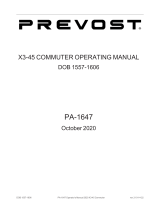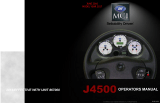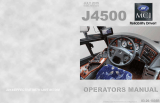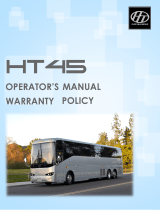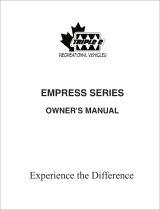Page is loading ...

COACH MANUFACTURER
OPERATOR’S MANUAL
X3-45 COACH
DOB Bus Number Series 2400-2489
July 2012

PA1592 July 2012
Featuring:
EPA2010 regulations engine with selective catalytic reduction SCR
system
First edition: October 2011
REVISION DESCRIPTION
July 2012 Introduction of 3-position ignition switch

Foreword
i
This PREVOST X3-45 coach Operator's
Manual conforms to the new EPA 2010
regulations, featuring an engine with selective
catalytic reduction SCR system. This manual
has been prepared for the Metropolitan
Transportation Authority (MTA) to thoroughly
acquaint the driver, with the equipment and
features of the coach in order to fully appreciate
and safely enjoy this vehicle. Prevost is
committed to the continuous improvement of
coach quality, reliability, durability and safety.
With innovative features, the X3 series coach was
designed with passenger and driver safety and
comfort in mind.
This manual contains information available at the
time of publication.
Driver's controls and instruments incorporate
advanced technology for enhanced driving ease
and security. This manual describes the main
features, instruments and controls, and servicing
requirements for the equipment. Read this
manual carefully to take advantage of the coach's
advanced features and to ensure optimum safety
and passenger comfort.
Keep this manual in the coach at all times. Make
sure this manual is kept with the coach when
ownership is transferred. Please use the
appropriate card at the end of this manual to
promptly notify Prevost of any change of address
or transfer of ownership. This will ensure we
provide fast and reliable coach service to all
coach operators.
DANGER, WARNING, CAUTION and NOTE. are
used throughout this manual to emphasize
important points when necessary:
DANGER
Directs the operator’s attention to unsafe
practices which could result in serious
personal injury or death.
WARNING
Directs the operator’s attention to unsafe
practices which could result in serious
personal injury or severe damage to the
vehicle.
CAUTION
Directs the operator’s attention to unsafe
practices where personal injury is not likely
but damage to vehicle components could
occur.
NOTE
Indicates supplementary information essential
to the proper operation of the vehicle.
The service life of the coach depends on the kind
of attention it receives. Pay close attention to the
DANGER, WARNING, CAUTION and NOTE.
Read the various notices and instructions posted
throughout the coach and attached to equipment.
Since continuous improvement is a primary focus at Prevost,
we reserve the right to make changes anytime, without notice,
and without incurring any obligation.
Before reproducing or copying this manual, in whole or in
part, written consent must be obtained from Prevost.


Table of Contents
iii
SAFETY PRECAUTIONS ................................................................................................ 1
COACH EXTERIOR ......................................................................................................... 5
COACH INTERIOR ....................................................................................................... 17
CONTROLS AND INSTRUMENTS ............................................................................... 23
OTHER FEATURES ...................................................................................................... 57
STARTING AND STOPPING PROCEDURE ................................................................. 83
SAFETY FEATURES AND EQUIPMENT ...................................................................... 89
CARE AND MAINTENANCE ......................................................................................... 99
TECHNICAL INFORMATION ...................................................................................... 115
ABBREVIATIONS ....................................................................................................... 123
APPENDIX A – SERVICE LITERATURE .................................................................... 125
APPENDIX B – TROUBLESHOOTING GUIDE FOR MULTIPLEX VEHICLES .......... 129
APPENDIX C – ALLISON DIAGNOSTIC TROUBLESHOOTING CODES ................. 135
INDEX ......................................................................................................................... 147


Safety Precautions 1
SAFE OPERATING PRACTICES ................................................................................................................ 2
DEFENSIVE DRIVING PRACTICES ............................................................................................................ 2
OTHER PRECAUTIONS .............................................................................................................................. 3

Safety Precautions
2
SAFE OPERATING PRACTICES
To ensure safe and reliable operation, heed the
following safety precautions.
Operation and maintenance of the vehicle
must be performed only by qualified
personnel.
Before driving, conduct a walk around
inspection and check that all baggage
compartment doors and equipment access
doors are securely shut.
Make sure good visibility is maintained at all
times. Keep windshields clean and free of
obstructions.
Adjust the driver's seat so that all controls
can be reached easily.
Always wear your safety belt when driving.
Check the instrument panel frequently. Do
not operate the vehicle when dials or
indicators do not indicate normal operating
conditions.
Always pay attention to pedestrians passing
in front and behind the vehicle. Always yield
to pedestrians at pedestrian walkways.
Do not drive over obstacles on the road.
Empty boxes, piles of leaves, and snowdrifts
could conceal hidden dangers that could
damage the vehicle suspension and
underbody.
When turning or changing lanes, signal your
intention well in advance.
When approaching to make a right turn,
reduce the space between the vehicle and
the curb to make sure another vehicle
cannot pass on the right. Since the vehicle
makes wide turns, allow enough space to
make safe turns.
Switch from high beams to low beams when
meeting or following other vehicles within
500 feet (150 meters).
Never leave the vehicle unattended with the
engine running or with the key in the ignition.
Turn off the engine, remove keys and apply
the parking brake before leaving the vehicle.
Shut-off the engine before refueling, adding
oil, performing maintenance or servicing
tasks, unless stated otherwise.
Fuel is highly flammable and explosive. Do
not smoke when refueling. Keep away from
open flames or sparks.
Do not run the engine or HVAC system with
access doors left open. Close compartment
doors before operating any equipment.
Do not remove the surge tank filler cap or
the cooling system pressure cap when the
engine is hot. Let the engine cool down
before removing filler caps.
Do not attempt to push or pull-start the
vehicle.
The service life of the vehicle depends on
the kind of maintenance it receives. Always
record any problems and report them
immediately to maintenance personnel.
DEFENSIVE DRIVING PRACTICES
For city driving, allow a four to six second
travel interval between your vehicle and the
vehicle ahead. Increase this travel interval to
six to eight seconds for highway driving.
Increase time interval for driving at night or
in foul weather.
Be prepared to stop when approaching an
intersection. The stopping distance of the
vehicle increases with the weight and speed.
Establish eye-to-eye contact with other
drivers and with pedestrians. Use, high
beam and low beam headlights, turn signals
and horn as needed.
On highway, don't stare at the road ahead.
Keep your eyes moving. Check mirrors and
dashboard instruments frequently.
To keep the vehicle from drifting across
lanes during highway driving, always look
over the horizon on the road ahead.
Adjust your speed to road conditions, traffic
and visibility. Never exceed the posted
speed limits.
If another vehicle is following close behind,
reduce your speed to let the vehicle pass.
For additional information about safe
operation and defensive driving practices,
contact the local department of motor
vehicles authority.

Safety Precautions
3
OTHER PRECAUTIONS
WARNING
This vehicle is not designed to carry standing
passengers.
DANGER
Make sure that electrical current or air
pressure is removed before performing any
work. A part may be energized even if the
ignition switch is OFF. A part may be under
pressure even if all tanks are empty. Before
performing any work on the vehicle, refer to
wiring diagrams and/or air schematics to
thoroughly understand the system.
CAUTION
Disconnect all electronic control modules
before welding. If modules (MCM, ECM, TCM,
ECU, ABS) are not disconnected before
welding is done, there is a high risk of
destroying the electronic components
(EPROM, Chip). Refer to procedure described
in Maintenance Manual.


Coach Exterior
5
ENGINE COMPARTMENT COMPONENTS ................................................................................................ 7
ENGINE COMPARTMENT ........................................................................................................................... 8
ENGINE COMPARTMENT CURB-SIDE DOOR ..................................................................................... 8
ENGINE COMPARTMENT REAR DOORS............................................................................................. 8
EXHAUST AFTERTREATMENT SYSTEM ACCESS DOOR ...................................................................... 9
ENGINE RADIATOR DOOR ........................................................................................................................ 9
CATALYTIC CONVERTER ACCESS DOOR ............................................................................................ 10
CONDENSER COMPARTMENT (A/C) ...................................................................................................... 10
EVAPORATOR COMPARTMENT ............................................................................................................. 11
COOLANT HEATER COMPARTMENT ..................................................................................................... 11
FRONT ELECTRICAL AND SERVICE COMPARTMENT ........................................................................ 12
BAGGAGE COMPARTMENTS .................................................................................................................. 12
FUEL AND DIESEL EXHAUST FLUID (DEF) FILLER DOOR .................................................................. 13
BI-FOLD ENTRANCE DOOR ..................................................................................................................... 14
DOOR OPERATION LOGIC .................................................................................................................. 14
EMERGENCY ENTRANCE DOOR OPENING ..................................................................................... 15
WHEELCHAIR LIFT ACCESS DOORS ..................................................................................................... 15
REAR VIEW MIRRORS .............................................................................................................................. 15
HUBODOMETER ........................................................................................................................................ 16

Coach Exterior
6
X3-45 EXTERIOR VIEW (TYPICAL) 18606
1. Engine Air Intake
2. Engine Compartment Curb-Side Door
3. Hinged Rear Fender
4. Fuel Filler Door
5. Condenser Compartment
6. Wheelchair Access Door
7. Lift Mechanism Access Door
8. Baggage Compartment
9. Entrance Door Control Switch
10. Bi-Fold Entrance Door
11. Electronic Destination Sign or Route
Number
12. Exhaust Aftertreatment System Access
Door
13. Engine Compartment Rear Doors
14. Rear-View Mirrors
15. Transmission Retarder OFF Indicator Light
16. Front Towing Air Supply Connectors
Access Door
17. Front Electrical And Service Compartment
18. Driver’s Power Window
19. Evaporator Compartment and Coolant
Heater Compartment.
20. Radiator Door
21. Catalytic Converter Access Door

Coach Exterior
7
ENGINE COMPARTMENT COMPONENTS
ENGINE COMPARTMENT FEATURING VOLVO D13 ENGINE 01184
1. Diesel Oxidation Catalyst (DOC) & Diesel Particulate Filter (DPF) Assembly;
2. Transmission fluid dipstick;
3. Coolant fluid surge tank filler cap;
4. Coolant fluid surge tank sight glass;
5. Air filter restriction indicator;
6. Engine oil dipstick;
7. Belt tensioner control valve;
8. Starter selector switch and Engine rear start push-button switch, Engine compartment Lights Switch;
9. Power steering fluid reservoir;
10. Radiator fan;
11. Radiator fan drive mechanism support;
12. Alternators;
13. Engine oil filler tube;
14. Central A/C compressor;
15. Air filter;

Coach Exterior
8
ENGINE COMPARTMENT
ENGINE COMPARTMENT CURB-SIDE DOOR
The engine compartment curb-side door
provides access to the following (if equipped):
Engine compartment rear doors release
handle;
Booster terminals;
Rear electrical panel;
Rear junction panel;
Battery compartment;
Air circuit fill valve and drain cock;
ENGINE COMPARTMENT CURB-SIDE DOOR 18559
This door can be locked or unlocked using the
exterior compartment key or, if so equipped, by
the central door locking system. To open, push
sideways on the small lever located between the
marker lights.
ENGINE COMPARTMENT R.H. SIDE 18607
NOTE
This compartment can be locked/unlocked
using the central locking system by pressing
the switch located on the L.H. side dashboard
panel.
A telltale light illuminates when one or more
compartments are unlocked.
ENGINE COMPARTMENT REAR DOORS
To open the engine compartment rear doors,
open the engine compartment curb side door
and pull the handle located on the rear door,
close to the bottom door hinge.
WARNING
Unless otherwise stated, do not run the
engine when the engine compartment is
open.
These doors swing out to provide access to the
following:
Engine;
Alternator(s);
Compressor(s);
Belt tension control valve (refer to chapter,
Care and Maintenance);
Engine starting selector (refer to chapter,
Starting and Stopping Procedures);
Coolant line shutoff valves;
Certification plates;
Engine coolant surge tank and filler cap;
Air filter restriction indicator;
Engine oil dipstick;
Power steering fluid reserve tank;
Allison automatic transmission fluid dipstick;
A catch holding each door open engages when
the door is fully open. Release the catches
before closing the doors. Close the L.H. door
first, then firmly shut the R.H. door.

Coach Exterior
9
OPENING ENGINE COMPARTMENT REAR DOORS 18608
Turn the lights ON in the engine compartment
using the switch on the rear start panel.
WARNING
Unless otherwise specified, do not run engine
when the engine compartment rear doors are
open. Close the engine compartment rear
doors before starting the engine.
EXHAUST AFTERTREATMENT
SYSTEM ACCESS DOOR
The engine door must be
open before opening the
exhaust aftertreatment
system access door. To
open the access door,
lower the latch release
lever, using a flat tip
screwdriver.
To close the door, lower the door and push
against the release lever spring to latch the door
shut.
ENGINE RADIATOR DOOR
First open the engine compartment doors before
opening the radiator door. The release lever is
located near the radiator. Push the release lever
forward to open the radiator door.
RELEASE LEVER
RADIATOR DOOR 18560
CATALYTIC CONVERTER ACCESS
DOOR
To gain access to the catalytic converter, open
the radiator door first. At the top of the radiator
compartment, pull the catch connecting rod to
unlock the catalytic converter access door and
lift the door open.
Hold the door open by inserting the support rod
free end into the receptacle located on the left
side of the DPF.

Coach Exterior
10
UNLOCKING CATALYTIC CONVERTER ACCESS DOOR
WARNING
After inserting the support rod into the
receptacle, make sure the rod supports the
door securely from falling down on to your
head or body.
ACCESS TO THE CATALYTIC CONVERTER 04023
WARNING
External and internal temperatures remain hot
long after engine has been shutdown. Allow
the Exhaust Aftertreatment System to cool
before handling. Wear protective clothing and
glove while servicing.
CONDENSER COMPARTMENT (A/C)
Pull the release latch located inside the adjacent
baggage compartment to open the condenser
door.
The condenser compartment provides access to
the following:
Diesel Exhaust Fluid (DEF) Tank
Condenser;
Condenser fans and motors;
Filter dryer and moisture indicator;
Receiver tank;
CONDENSER COMPARTMENT (A/C) 22299
CAUTION
Only the strap should be used to pull the
condenser-fan assembly open. Damage to
condenser could result if pulling by other
means.
CONDENSER COMPARTMENT STRAP
EVAPORATOR COMPARTMENT
The HVAC (Heating, Ventilating and Air-
Conditioning) evaporator blower and coolant
heater compartment are located in this
compartment. The compartment door release
latch is located on the right side of the baggage
compartment and to the left of the HVAC
compartment door. Pull the release latch then
swing the HVAC compartment door open.

Coach Exterior
11
EVAPORATOR COMPARTMENT
EVAPORATOR COMPARTMENT 22274
RECIRCULATION DAMPER 22302
In case of damage or malfunction of the
evaporator compartment door release latch, the
door can still be opened using the access hole
located forward of the compartment.
Insert a small rod through the access hole to
release the latch.
EVAPORATOR COMPARTMENT DOOR RELEASE LATCH
ACCESS HOLE
COOLANT HEATER COMPARTMENT
The water recirculating pump is located aft of the
evaporator compartment and inside the engine
coolant heater compartment and accessible
through the evaporator compartment door. The
air dryer may also be located in this
compartment or in the middle of the rear
wheelhousing, above the drive axle.
COOLANT HEATER COMPARTMENT

Coach Exterior
12
FRONT ELECTRICAL AND SERVICE
COMPARTMENT
To open the front electrical and service
compartment door, pull the rod inside the
vehicle, next to the driver’s power window or use
the key to open from outside the coach. The
front electrical and service compartment
provides access to the following:
Front terminal block;
VECU with Volvo D13 engine;
Vehicle Electrical Center Front (VECF),
MCM and Multiplex Modules;
Relays and fuses;
Tag axle control valve lever;
ABS Electronic Control Unit (ECU);
Emergency door opening unlatch valve;
Windshield washer reservoir;
Accessory system fill valve;
Accessory air tank drain valve;
Jack and tools.
FRONT SERVICE COMPARTMENT DOOR 18610
This compartment door can be locked/unlocked
using the exterior compartment key.
The light in the front electrical and service
compartment turns ON automatically when the
door is opened.
NOTE
Jack and tools are located inside the front
electrical and service compartment.
FRONT ELECTRICAL COMPARTMENT 06673
FRONT SERVICE COMPARTMENT 18611
BAGGAGE COMPARTMENTS
The baggage compartments of the X3-45 Coach
may be locked using a seal on the operating
handle.
BAGGAGE COMPARTMENT HANDLE
If necessary, the baggage compartments of the
X3-45 Coach provide 406 ft3 (11.5 m3) of
storage capacity. The compartments can be
locked or unlocked by using the exterior
compartment key. Pull up operating handle to
release the latch, and then pull the door open.
Pressurized cylinders assist the opening and
closing of the baggage compartment doors and
hold the doors open.

Coach Exterior
13
BAGGAGE DOOR LOCK AND LEVER 18043
To close, pull the door down by the handle rod.
Complete the closing of the door by returning
the operating handle to its initial position.
CAUTION
Do not slam shut the baggage compartment
doors. Damage to door weather-stripping or
locking mechanism could result.
Lights in the baggage compartments turn ON
automatically when the door is opened.
BAGGAGE DOOR CATCH 18612
NOTE
For added safety, open the door until the
catch assist in holding the door in the open
position.
NOTE
The baggage compartment doors can be
locked/unlocked from the driver's position by
the optional central locking system. The switch
is on the L.H. control panel. Refer to "Controls
& Instruments" chapter.
WARNING
To avoid injury, keep hands clear of baggage
compartment door edge and door frame when
closing.
NOTE
To prevent theft and vandalism, always lock
the baggage compartment doors before
leaving the vehicle unattended.
FUEL AND DIESEL EXHAUST FLUID
(DEF) FILLER DOOR
The fuel and Diesel Exhaust Fluid (DEF) filler
door is located on the R.H. side of the coach
providing easy filling. A spring keeps the door
either open or shut. The vehicle is equipped with
Emco Wheaton POSI/LOCK 105 Automatic
DRY-BREAK Fuelling System; the POSI/LOCK
Filler Neck Assembly is installed on the fuel tank
and requires the use of POSI/LOCK Refueling
Nozzle for proper operation.
FUEL & DEF FILLER DOOR 03046
NOTE
Provided the vehicle is parked on level
ground, an automatic nozzle will automatically
shut off when fuel tank is approximately 95%
full.

Coach Exterior
14
CAUTION
Diesel exhaust fluid DEF will begin to
crystallize and freeze at 12°F (-11°C) and
expand by 7% when frozen. To allow
expansion without damaging the DEF tank, do
not fill the tank with more than 15.9 gallons
(60 liters).
CAUTION
Do not fill to more than 95% of the fuel tank
capacity. Do not "top off" the tank, doing so
may result in fuel spillage when the fuel
expands.
BI-FOLD ENTRANCE DOOR
Lock or unlock the bi-fold entrance door from
outside the vehicle by turning the key in the door
lock (counterclockwise to lock, clockwise to
unlock). The entrance door can be unlocked
from the inside using the small lever located on
the door.
From outside, open the door by pushing the
switch forward, close by pushing the switch
rearward.
ENTRANCE DOOR EXTERIOR SWITCH 18599
From the inside, open the door by pressing the
door opening switch (L.H. button) on the R.H.
dashboard panel. The door will open to full open
position within 5 seconds.
Close by pressing and holding the door closing
switch (R.H. button) on the dashboard. If the
closing switch is released before the door is fully
closed, the door will stop in that position. Refer
to “Controls and Instruments” chapter for more
information.
ENTRANCE DOOR 18001
ENTRANCE DOOR & WIPER CONTROL PANEL 06614
DOOR OPERATION LOGIC
If the switch is held in position until the door is
fully open or closed, the system holds pressure
in the door cylinder, locking the door in that
position. A proximity sensor will finish the closing
of the door when it senses the door is almost
shut.
The door can be closed to any position by
releasing the switch (or button, if inside) when
the desired position is attained. However, the
door is not locked in any position other than fully
closed. The door can then be closed further by
pushing or pulling on the door.
/
